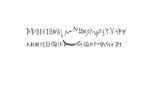User talk:Simon/Writing
notes from My Mother Was A Computer by N. Katherine Hayles
Notes made while doing a close reading of N. Katherine Hayles' book.
pad here: https://pad.xpub.nl/p/my_mother_was_a_computer_notes
Chapter 4 - Translating Media
From Print to Electronic Texts (pg 89)
- Borges - "The Don Quixote of Pierre Menard" - the recreation of Don Quixote (even though word-for-word) is a different work due to the cultural context it was produced in
- the transformation of a print document into an electronic text is a form of translation "media translation"
- Dene Grigar in Mutability, Medium & Character - "something is gained as well as lost in translation"
- our notions of textuality are shot through with assumptions specific to print
What is a text? (pg 91)
- work, text, document
- a work = "an abstract artistic entity"
- editors think it makes sense to talk about a text, separate from its physical embodiment in an artifact
- Peter Shillingsburg: a text is "the actual order of words and punctuation as contained in any one physical form, such as manuscript, proof or book"
- problems with this: the text remains the same though the signs for it are different
- later definition from Shillingsburg: a text is "a compound of matter, concept and execution"
- thinking of a text as the order of words and punctuation is print-centric, also presumes the text resides at one location
- in texts assembled on the fly, the text as actual order of words and punctuation does not exist in data files
- text comes into existence as a process
- Shillingsburg's definition fails to account for qualities such as colour, font size and shape, and page placement, not to mention electronic-specific effects such as animation, mouseovers, instantaneous linking
- Platonic definition of a "work" creates "a desire to suppress unruliness and multiplicity in order to converge on an ideal "work"
- Translating texts into electronic documents - TEI (Text Encoding Initiative) community arrived at the principle of OHCO (ordered hierarchy of content objects)
- Mats Dahlström: the markup of a text is "a theory of this text, and a general markup language is a general theory or conception of text"
- Three positions within the text encoding community
- OHCO: a text consists of a hierarchical set of objects (such as chapters, sections, subsections, paragraphs and sentences), a Platonist perspective
- pluralism: a text consists of not just one hierarchy, but several interpenetrating hierarchies (e.g. a verse drama which can be parsed as sentences or metrical lines), epistemologically, texts are systems of ordered hierarchies, DTDs (document type definitions) were designed to introduce more flexibility into the system
- antirealism (Renear): "text does not preexist encoding as a stable ontological object but is brought into existence through implicit assumptions actualized through encoding procedures". Pichler: "Our aim in transcription is not to represent as accurately as possible the originals, but rather to prepare from the original another text so as to serve as accurately as possible certain interests in the text." Ambiguities: Which certain interests?
- All three positions focus almost exclusively on linguistic codes, allowing them to leave the document as physical artefact out of the discussion
- Although the editors of the William Blake Archive recognise the book as a physical object, they implicitly understand the bibliographic in terms of the visual
- The feel and smell of a book cannot be reproduced in digital codes
- Choices about which aspects to encode (in the William Blake Archive) are heavily weighted towards the linguistic rather than the bibliographic
- "There are only physical objects such as books and computers, foci of attention, and codes that entrain attention and organize material operations. Since no print books can be completely encoded into digital media, we should think about correspondences rather than ontologies, entraining processes rather than isolated objects, and codes moving in coordinated fashion across representational media rather than mapping one object onto another."
Physicality, Materiality and Embodied Textuality (pg 97)
- editors seek to separate the work from its physical instantiation
- Jerome McGann in Radiant Textuality writes of experiments in failure dubbed "deformations"

